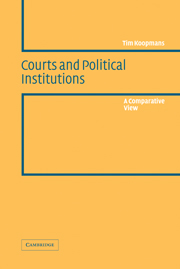Book contents
- Frontmatter
- Contents
- Preface
- Table of cases
- List of abbreviations
- 1 Introduction
- 2 The Sovereignty of Parliament
- 3 Judicial review of legislation
- 4 The growth of judicial power
- 5 The limits of judicial review
- 6 The legality of administrative action
- 7 Courts and governments
- 8 Courts and individual rights
- 9 Techniques of judicial protection
- 10 A glance at the future
- Select bibliography
- Index
2 - The Sovereignty of Parliament
Published online by Cambridge University Press: 26 February 2010
- Frontmatter
- Contents
- Preface
- Table of cases
- List of abbreviations
- 1 Introduction
- 2 The Sovereignty of Parliament
- 3 Judicial review of legislation
- 4 The growth of judicial power
- 5 The limits of judicial review
- 6 The legality of administrative action
- 7 Courts and governments
- 8 Courts and individual rights
- 9 Techniques of judicial protection
- 10 A glance at the future
- Select bibliography
- Index
Summary
The parliamentary model
Relations between courts and political institutions cannot be properly assessed without a prior definition of the powers of the courts with regard to legislation. Do judges have to respect statutes validly approved by the competent political institutions in all circumstances, or are they, on the contrary, entitled to set aside or disregard statutes which, in their view, violate rules of higher law, for example, those of the constitution? This problem shows an interesting dissimilarity between the solutions adopted in British and in American constitutional law, which we shall consider first.
In nineteenth-century Britain, constitutional doctrine and constitutional practice came very close to what I shall call the ‘parliamentary model’. In this model legislation adopted by Parliament is supreme: it cannot be challenged – not by the head of State, not by the government, not by the courts, not by the citizens.
The British doctrine of the sovereignty of Parliament embodied that rule: by issuing a statute, an Act of Parliament, the legislative bodies had the final say. No court was entitled to question the legal validity of a statute; and every law-making body in the country was subject to it. For this doctrine, it is for the moment of no relevance that the term ‘legislative bodies’ includes not only both houses of Parliament – the House of Commons and the House of Lords – but also the Queen (or King), who must give the Royal Assent to a bill passed by both houses to sign it into law, under the responsibility of the Prime Minister.
- Type
- Chapter
- Information
- Courts and Political InstitutionsA Comparative View, pp. 15 - 34Publisher: Cambridge University PressPrint publication year: 2003



